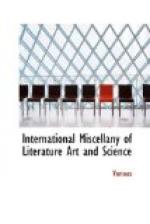For eight years, according to Chantrey himself, he did not gain L5 by his modeling. A fortunate commission, however—the bust of Horne Tooke—finally obtained for him other commissions, amounting altogether To L12,000. In 1811 “he married his cousin Miss Wale; with this lady he received L10,000; this money enabled him to pay off some debts he had contracted, to purchase a house and ground, on which he built two houses, a studio and offices, and also to buy marble to proceed in the career he had begun.” In 1812 he executed for the city of London a statue in marble of George III., placed in the council-chamber of Guildhall, and in 1817 he produced the exquisite monument—not to be surpassed for tenderness of sentiment and poetic beauty—of the two children whose death this piece of sculpture now commemorates in Lichfield cathedral. With this achievement the race was won. In 1818 he was elected an associate of the Royal Academy, and as soon after as the practice of the Academy admitted he was elevated to the rank of Academican.
From this period until his death, in 1841, the career of the sculptor was a series of noble and well rewarded efforts. He amassed a fortune, which at his death he bequeathed to the Royal Academy for the promotion of British art. He was a favored subject of three successive Sovereigns, and the friend and companion of the most illustrious among his contemporaries. His death was somewhat singular. For two years he had been in a declining state of health, but his condition had given his friends no immediate alarm. On the 22d of November he wrote to Sir Charles Clarke, from Norwich, expressing his intention to go to town on the following day, and announcing an invitation to Audley-end, which he had accepted for the 8th of the following month. On Thursday, the 25th of November, a friend called at his house in London, between 5 and 6 o’clock, and was pressed to dine. As he could not do so, Chantrey accompanied his visitor on his way home as far as Buckingham Palace, complaining on the way of a slight pain in the stomach, but at the same time receiving his friend’s condolences with jokes and laughter. The clock struck 7 when the friends shook hands and parted. At 9 Chantrey was dead.
Let us regard Chantrey from what point we may, the features that present themselves to the observer bear the same unmistakable stamp. As sculptor and as man, at home or abroad, in his serious recreations or pleasurable pursuits, in his temper and social bearing, Francis Chantrey was a thorough Englishman. Heaven endowed him with genius, and his sound sense enabled him to take the precious gift as a blessing. Sheffield, that reared him, had no cause to be uneasy on his account; the prudence and shrewdness of the North were admirably mingled with the aesthetic qualities of the South. In the pocketbook which accompanied the sculptor on his Italian tour, notes were found referring to the objects of art visited on the way, and in the same tablet were accurate accounts of expenditure and the current prices of marble. Avoiding as much as possible the treatment of purely poetical subjects, Chantrey by the force of simplicity idealized the most ordinary topics. He shrank from allegory by a natural instinct, yet his plain unadorned forms have the elevation and charm of a figurative discourse. “Chantrey,” says Mr. Jones.




